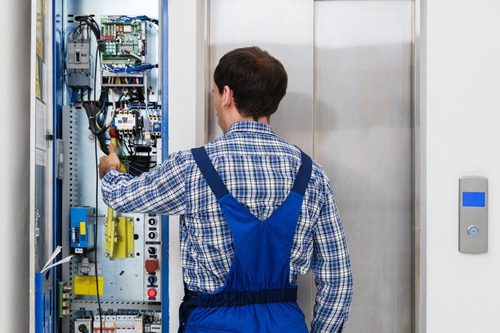Platform Lift Dimensions Explained: Why They Matter for Lift Servicing
Lift Maintenance RepairElevator Suite Britannia Street Tividale B69 2PG
01926 266127
An Extensive Method to Enhancing Efficiency With Strategic Lift Fixing Techniques
A organized and critical method to raise repair work and upkeep is vital to make best use of performance and minimize downtime. By resolving common lift problems, implementing positive upkeep steps, and establishing targeted repair work strategies, centers can optimize their lift systems to run at peak performance degrees.
Significance of Lift Performance Optimization
Comprehending the significance of enhancing lift efficiency is important for ensuring efficient and trustworthy vertical transport systems in different structures and frameworks. Lifts are essential elements of modern infrastructure, giving vertical mobility for residents and products within structures of varying heights. By enhancing lift performance, structure owners and facility managers can enhance customer experience, enhance power effectiveness, and rise general functional performance.
Reliable lift efficiency optimization involves numerous elements, consisting of speed, capacity, power security, upkeep, and consumption demands. Effectively optimized lifts can decrease wait times for users, especially in high-traffic structures, leading to boosted fulfillment and performance. Additionally, optimized lifts contribute to power savings by making use of sophisticated control systems and innovations that reduce power consumption without endangering efficiency.

Identifying Common Lift Issues
Recognizing usual lift problems is crucial for preserving the functional efficiency and security of vertical transportation systems in buildings. This problem can be a sign of issues with the lift's electric motor, control system, or also the alignment of the lift automobile.
One more common lift problem is weird noises emanating from the lift shaft or equipment area. These sounds can vary from grinding or scraping sounds to loud clunking sounds, every one of which might signify underlying mechanical concerns that require prompt focus. In addition, constant door breakdowns, such as doors not opening up or shutting effectively, can interfere with the smooth circulation of guests and pose safety and security threats.
Applying Aggressive Upkeep Actions
To maximize the performance and longevity of lift systems, proactive maintenance measures play an important role in guaranteeing operational integrity and security. lift repair. Executing aggressive upkeep includes systematically examining, maintenance, and repairing components prior to they stop working, thus preventing pricey downtime and prospective safety dangers. Regularly arranged evaluations can aid determine minor issues before they escalate into major troubles, eventually expanding the life expectancy of lift systems
One key facet of positive upkeep is developing a thorough upkeep routine based on supplier suggestions and sector best techniques. This routine should detail jobs such as lubrication, positioning checks, and part replacements at defined intervals. Furthermore, applying condition surveillance strategies, such as vibration evaluation and thermal imaging, can aid find very early indications of wear or breakdown.
Furthermore, training maintenance personnel on proper assessment techniques and our website precautionary upkeep treatments is vital for the successful implementation of positive maintenance actions. By promoting a culture of proactive maintenance within a company, lift systems can run at peak efficiency levels, lessening disturbances and ensuring the security of individuals.
Creating Targeted Fixing Strategies
Upon assessing the maintenance records and performance information, the design group can establish targeted fixing strategies to attend to certain problems and enhance lift system functionality. These fixing strategies are customized to the determined issues, guaranteeing that sources are concentrated on resolving critical concerns effectively. By prioritizing fixings based upon their influence on performance and safety, the targeted repair strategies assist reduce downtime and maintenance prices while maximizing the lift system's integrity.
Establishing these plans involves a thorough evaluation of the lift system components, consisting of motors, cable televisions, More about the author brakes, and control systems. Through this in-depth assessment, the design team can determine the source of any breakdowns or deterioration in performance. This details is then made use of to produce a roadmap for the fixing process, outlining the essential steps, timeline, and sources required to attend to each issue properly.
Furthermore, targeted fixing plans might consist of preventative procedures to boost the lift system's longevity and efficiency. By proactively resolving prospective issues prior to they escalate, these plans add to the overall efficiency and security of the lift system.
Making Use Of Data-Driven Insights
Utilizing the power of data-driven insights is vital in maximizing lift system efficiency and upkeep efficiency. These anticipating upkeep strategies aid stop unanticipated failures, reduce downtime, and expand the life-span of lift systems.

Verdict
In conclusion, optimizing lift efficiency is crucial for ensuring effectiveness and security in structures. By determining site common lift issues, executing positive maintenance steps, establishing targeted repair strategies, and making use of data-driven understandings, companies can boost efficiency and reduce downtime. It is essential to take an extensive technique to lift repair work techniques to optimize operational performance and make sure the longevity of lift systems.
By attending to common lift problems, carrying out positive maintenance measures, and creating targeted fixing strategies, facilities can optimize their lift systems to run at peak efficiency degrees.Another widespread lift problem is unusual noises rising from the lift shaft or machinery room.Upon assessing the upkeep records and efficiency information, the design team can develop targeted fixing strategies to enhance and address certain issues lift system capability. By focusing on repair services based on their impact on efficiency and security, the targeted fixing strategies assist minimize downtime and upkeep costs while taking full advantage of the lift system's reliability.
It is vital to take an extensive strategy to lift fixing techniques to make the most of functional efficiency and make certain the longevity of lift systems.